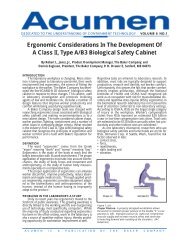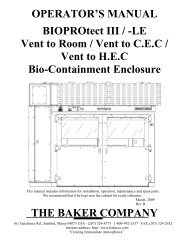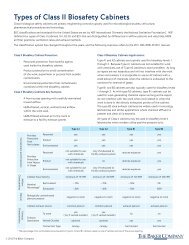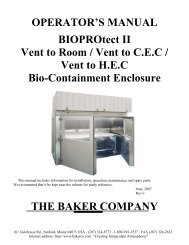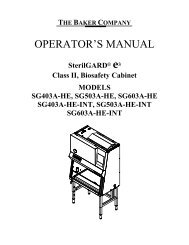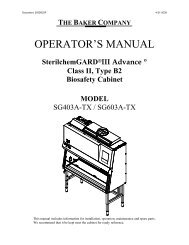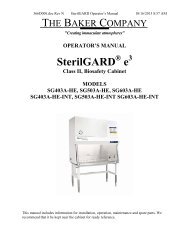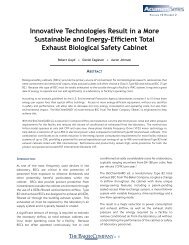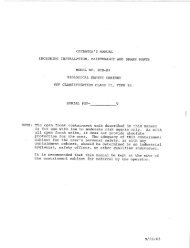SterilGARD III Advance SG403 / SG603 - Baker Company
SterilGARD III Advance SG403 / SG603 - Baker Company
SterilGARD III Advance SG403 / SG603 - Baker Company
Create successful ePaper yourself
Turn your PDF publications into a flip-book with our unique Google optimized e-Paper software.
20409. and NSF Standard 49 1992 Class II (Laminar Flow) Biohazard Cabinetry, Annex G<br />
(Recommended Microbiological Decontamination Procedure). Available through NSF<br />
International 789 N. Dixboro Road, Ann Arbor, MI. 48105-9723.<br />
3 An ethylene oxide/nitrogen gas mixture is an alternative. Using this gas is more<br />
complicated than formaldehyde.<br />
4 Whatever gas you choose, have the proper safety equipment (gas masks, protective<br />
clothing, etc.) within easy reach. In addition, you will want to be sure that the gas you are<br />
using will be effective against all of the biological agents within the cabinet. When you<br />
have decided which gas to use, post the antidote to it in a visible and nearby location. The<br />
volume of the cabinets is listed in “Specifications”. Provide the correct amount of<br />
decontaminating gas for the cabinet volume.<br />
5 Carcinogens present a unique chemical deactivation problem and the standard biological<br />
decontamination will not, of course, be effective against chemicals or other non-biological<br />
materials. With materials of this kind, consult a qualified safety professional.<br />
Procedure<br />
1 Surface-disinfect the inside of the window and all other surfaces on the view screen<br />
assembly.<br />
2 Multiply the total volume of the cabinet (look in “Specifications”) by 10.59 g/m 3 ( 0.3 g/ft 3)<br />
of space to determine the amount of paraformaldehyde required to decontaminate the<br />
cabinet. If the cabinet is vented to the outside you must consider the volume of the duct<br />
work in the paraformaldehyde calculation.<br />
3 Close all gas or flammable petcocks tight. Use a soap bubble solution to check for leaks.<br />
4 Place a pan of water in the work space. If the relative humidity is 10% to 30% use boiling<br />
water. If 40% to 55% use hot tap water. If above 85% skip this step (extra humid air will<br />
require extra cleanup.) The purpose of the water is to adjust the relative humidity in the<br />
cabinet. Without the proper relative humidity the formaldehyde gas will not be effective.<br />
Formaldehyde gas enters living organisms through cell walls by the absorption of water.<br />
5 Place a heating mantle with paraformaldehyde in the workspace. The heating mantle must<br />
be able to reach 232 0 C/450 degrees F and must have a grounded plug plugged in outside<br />
the cabinet.<br />
6 Place a second heating mantle in the cabinet with 10% more by weight of ammonium<br />
bicarbonate than paraformaldehyde. This will be used later in step 14 to neutralize the<br />
formaldehyde gas.<br />
7 This step is optional. A Place spore strip inside the cabinet to confirm the decontamination<br />
process has been successful.<br />
8 Seal the front viewscreen opening and top exhaust opening with a large piece of plastic.<br />
Start at the top rear and extending the plastic over the top front down to the bottom of the<br />
access opening. taping all edges This will allow exhaust to circulate back to the cabinet<br />
blower distributing formaldehyde gas through the exhaust filter.<br />
9 Turn on the heating mantle.<br />
10 After 25% of the paraformaldehyde has depolymerized, turn on the cabinet blower for 10 to<br />
15 seconds. Repeat after 50%, 75% and 100% of the paraformaldehyde has<br />
depolymerized.<br />
11 Wait at least 4 to 6 hours, preferably overnight.<br />
17



